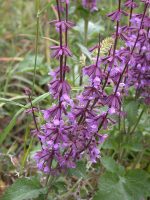
Native to Mediterranean woodlands and shrub lands, this tender herbaceous perennial is a member of the deadnettle family, Lamiaceae, that also includes mint, rosemary, and beebalm. The plants grow up to 3′ tall and have 4-angled, stiff stems carrying paried, wrinkled leaves with toothed margins. From mid-spring into summer the 3/4″ long violet flowers are borne in whorls of 6-12 and are strongly 2-lipped. The inflorescence consists of a strong central spike and 3 pairs of lateral branches that bend upwards and inwards. Gideon-Pisanty-Wikipedia
Historians think that the inflorescence resembles a menorah, the seven-branched Jewish ceremonial candlestick.
Exodus 37 (NIV) The building of the furnishings of the tabernacle is described.
17. “They made the lampstand of pure gold. They hammered out its base and shaft, and made its flowerlike cups, buds and blossoms of one piece with them.”
18. “Six branches extended from the sides of the lampstand—three on one side and three on the other.”
Judean sage likes full sun to partial shade and average, medium moist, well-drained soil in USDA Hardiness Zones 8-11. The plants are healthy and have no significant diseases or pests. Propagation is by seed. The plant has been used since ancient times as a medicinal herb and is an attractive addition to a medicinal herb garden or garden border.
The genus name, Salvia, comes from the Latin salvere, meaning to save, and refers to the healing properties of the plant. The specific epithet, judaica, is from the Hebrew יהודה, Yehudah, Judah, the name given to the mountainous southern part of the Land of Israel.